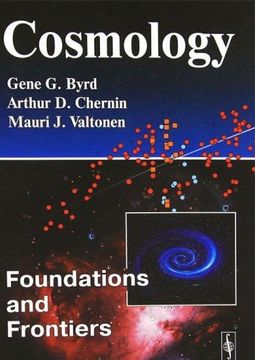Compartir
Cosmology: Foundations and Frontiers (en Inglés)
Byrd Gene G.,Chernin Arthur D. (Autor)
·
Editorial Urss
· Tapa Blanda
Cosmology: Foundations and Frontiers (en Inglés) - Byrd Gene G.,Chernin Arthur D.
Ciencia y matemáticas
28,41 €
29,90 €
Ahorras: 1,50 €
Elige la lista en la que quieres agregar tu producto o crea una nueva lista
✓ Producto agregado correctamente a la lista de deseos.
Ir a Mis ListasSe enviará desde nuestra bodega entre el
Jueves 16 de Mayo y el
Martes 21 de Mayo.
Lo recibirás en cualquier lugar de España entre 1 y 5 días hábiles luego del envío.
Reseña del libro "Cosmology: Foundations and Frontiers (en Inglés)"
Encuadernación: cartoné.Recent discoveries in cosmology have changed this science drastically. In a new world picture emerging now, the major feature is the "dark energy" of vacuum which contributes about 3/4 to the total energy of the observed Universe. Predicted theoretically by Einstein in 1917, this unusual cosmic energy produces not gravity, but antigravity. Antigravity makes the Universe expand with acceleration.This is one of the first books in current literature which treat the newest most exciting ideas and discoveries in the science of the Universe. The book provides an easy introduction to both classic foundations and modern developments in cosmology for students, as well as interested physicists and astronomers working in other fields. Only a basic background in calculus, differential equations, and vectors is expected from the reader. Throughout the text, boxes present interesting side areas or background material while exercises promote active understanding.Preface1 Fundamental discoveries in cosmology1.1. World of galaxies1.2. Cosmological expansion1.3. Cosmic Microwave Background1.4. Dark matter1.5. Dark energy.2 General Relativity and cosmology2.1. Spacetime2.2. Principle of Equivalence2.3. The Schwarzschild metric2.4. Orbits2.5. Deflection of light2.6. Black Holes2.7. Rotating Bodies2.8. Rotating Black Holes2.9. Curvature of 3-space2.10. Expanding Universe2.11. The scale factor2.12. Newtonian cosmology2.13. The early Universe2.14. Gravitational waves.3 Standard cosmological model3.1. The observed Universe3.2. Cosmic microwave background radiation3.3. Baryonic matter3.4. Dark matter3.5. Cosmic vacuum3.6. Physics of vacuum3.7. Cosmic energy composition3.8. Three epochs of cosmic evolution3.9. Big Bang Nucleosynthesis3.10. Cosmic plasma and radiation.4 Gravitational instability4.1. Newton's idea4.2. Hydrodynamics4.3. Jeans Criterion4.4. Jeans length for collisionless gas4.5. Jeans mass in the expanding Universe4.6. Dynamics of gravitational instability4.7. The mass contained in early structures4.8. Perturbations of the gravitational potential4.9. Rotational perturbations4.10. Gravitational waves: tensor perturbations4.11. Radiation damping4.12. Radiation friction4.13. Plasma diffusion4.14. Free streaming in dark matter4.15. Dark matter perturbations at radiation domination4.16. Dark matter drag4.17. Isothermal perturbations after recombination4.18. Termination of gravitational instability.5 Formation of large scale structure5.1. Harrison--Zeldovich spectrum5.2. Evolution of the spectrum at lower scales5.3. Power Spectrum5.4. Galaxy groups and the vacuum dominated Hubble flow5.5. Perturbations and cosmic microwave background5.6. Observing CMB anisotropy5.7. Correlations5.8. The Virial Theorem5.9. Cosmic Energy Equation5.10. Nonlinear perturbations: spherical solution5.11. Tolman solution5.12. Nonlinear perturbations: plane solution5.13. Zeldovich flow in vacuum background5.14. Distributions of Halos5.15. Baryons in Galaxies5.16. Numerical Simulations.6 Evidence for dark matter6.1. The Milky Way and other disk galaxies6.2. The Local Group of Galaxies6.3. Relaxation Time6.4. Dynamical Friction6.5. Equilibrium distributions of stellar systems6.6. Weighing the clusters6.7. Sunyaev--Zeldovich Effect6.8. Subclusters6.9. Gravitational Lensing.7 Evolution of galaxies7.1. Quasars7.2. Binary Black Holes7.3. The General Three-Body Problem7.4. Three Black Holes7.5. Intergalactic Black Holes7.6. The Population of Escapers7.7. Forming stellar systems7.8. The Lyman alpha Forest.8 Current results, problems and ideas8.1. Is the Universe finite?8.2. Cosmic internal symmetry8.3. Gravity-electroweak interplay8.4. Cosmic coincidences8.5. Why does space look flat?8.6. Cosmic entropy8.7. The gross figures8.8. Extra dimensions8.9. What is natural?8.10. Why does the Universe expand?8.11. Why is the Universe uniform?.ReferencesIndex
- 0% (0)
- 0% (0)
- 0% (0)
- 0% (0)
- 0% (0)
Todos los libros de nuestro catálogo son Originales.
El libro está escrito en Inglés.
La encuadernación de esta edición es Tapa Blanda.
✓ Producto agregado correctamente al carro, Ir a Pagar.

